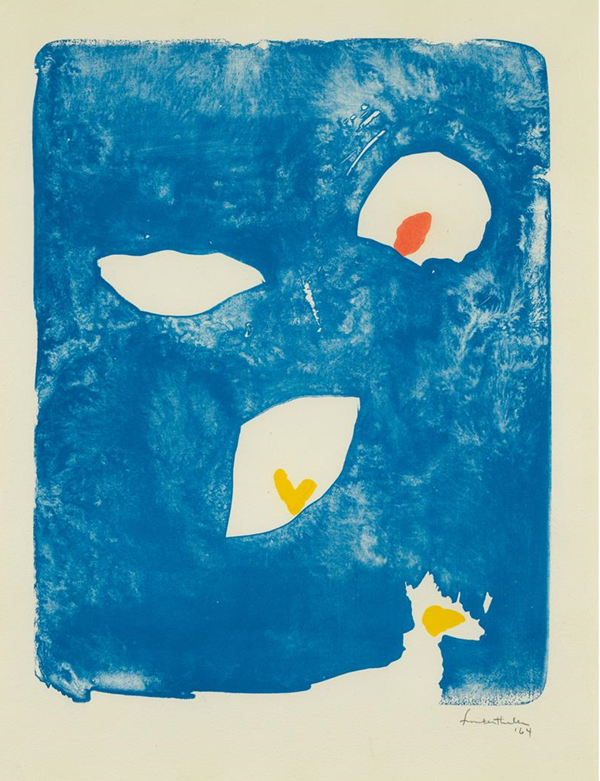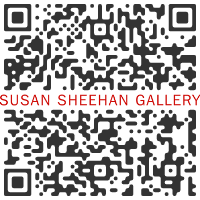"Solairum, 1964"
Helen Frankenthaler

SUSAN SHEEHAN GALLERY
136 East 16th Street New York, NY 10003Tel 212 489-3331 Fax 212 489-4009 e-mail:



January, 2021
Helen Frankenthaler (1928-2011) first achieved acclaim for her abstract paintings in the early 1950s. Although best known for her large-scale paintings on unprimed canvas, which she called the "soak-stain technique," Frankenthaler also made major contributions to the field of printmaking. Initially reticent that the medium would restrict her ability to experiment and improvise, Frankenthaler quickly discovered that printmaking enabled her to do just that. Solarium (1964)—one of her first prints—is an important example of her rapid embrace and mastery of the lithograph technique.
Frankenthaler made her foray into printmaking 1961 when Tatyana Grosman, founder of Universal Limited Art Editions (ULAE), invited the artist to her then-new printmaking workshop on Long Island, New York. Frankenthaler's first print was a lithograph aptly titled First Stone (1961), which she executed with the help of master printer Robert Blackburn. She produced four more prints at ULAE in the early 1960s using lithography and aquatint, often working with Donn Steward, who would soon become another master printer at ULAE. Steward aided Frankenthaler in the creation of Solarium alongside esteemed printer Zigmunds Priede. In the following decades, Frankenthaler continued to work with many of the world's most important master printers and print workshops.
While First Stone features swathes of color floating on the page, Solarium reads like an inverse of her typical approach to painting and printmaking. Negative spaces throughout the bright blue ink create rigid yet organic, flower-like shapes. The clean lines of Solarium indicate Frankenthaler's quickly-acquired command of the medium.
Frankenthaler's first five prints—of which Solarium was the fifth—were published by ULAE in editions of less than 25, making them especially rare today. Solarium, produced in an edition of just 18, is in the collection of numerous major museums, including The Museum of Modern Art in New York, the Art Institute of Chicago, and the National Gallery in Washington, D.C.
As her career progressed, Frankenthaler explored other print mediums, including woodcut, aquatint, and etching, and continued to experiment with lithography. She constantly found new ways to alter or combine techniques to achieve her desired image. Thus, like her paintings, Frankenthaler's prints marry her formal and conceptual approaches to artmaking through her unconventional use of familiar mediums and materials in a quintessentially modern way. She produced a robust body of prints over the course of her career and continued to explore the possibilities of the print medium up until the last years of her life.
Frankenthaler made her foray into printmaking 1961 when Tatyana Grosman, founder of Universal Limited Art Editions (ULAE), invited the artist to her then-new printmaking workshop on Long Island, New York. Frankenthaler's first print was a lithograph aptly titled First Stone (1961), which she executed with the help of master printer Robert Blackburn. She produced four more prints at ULAE in the early 1960s using lithography and aquatint, often working with Donn Steward, who would soon become another master printer at ULAE. Steward aided Frankenthaler in the creation of Solarium alongside esteemed printer Zigmunds Priede. In the following decades, Frankenthaler continued to work with many of the world's most important master printers and print workshops.
While First Stone features swathes of color floating on the page, Solarium reads like an inverse of her typical approach to painting and printmaking. Negative spaces throughout the bright blue ink create rigid yet organic, flower-like shapes. The clean lines of Solarium indicate Frankenthaler's quickly-acquired command of the medium.
Frankenthaler's first five prints—of which Solarium was the fifth—were published by ULAE in editions of less than 25, making them especially rare today. Solarium, produced in an edition of just 18, is in the collection of numerous major museums, including The Museum of Modern Art in New York, the Art Institute of Chicago, and the National Gallery in Washington, D.C.
As her career progressed, Frankenthaler explored other print mediums, including woodcut, aquatint, and etching, and continued to experiment with lithography. She constantly found new ways to alter or combine techniques to achieve her desired image. Thus, like her paintings, Frankenthaler's prints marry her formal and conceptual approaches to artmaking through her unconventional use of familiar mediums and materials in a quintessentially modern way. She produced a robust body of prints over the course of her career and continued to explore the possibilities of the print medium up until the last years of her life.

 | Helen Frankenthaler |
mpefm
NEW ACQUISITIONS art press release









